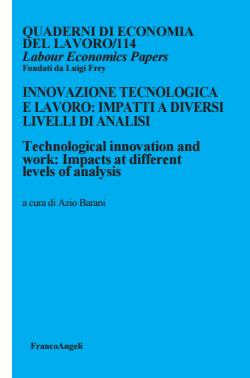
LIBRI DI MARCO FREY
La ricerca ha estratto dal catalogo 60 titoli


This book, which focuses on a high risky sector (environmental hygiene sector), aims to analyse the degree to which health and safety managerial tools are applied inside waste management companies. The book supports academic debate and practitioners, providing empirical evidences and managerial indications for promote safety inside the companies.
cod. 365.1085
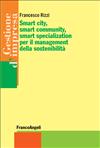
Le smart city, le smart community e le smart specialization rappresentano tre dimensioni, fra loro spesso interconnesse, della strategia europea per la competitività economica al 2020. Un volume per comprendere il rapporto tra sviluppo tecnologico, sviluppo dei mercati e perseguimento del proprio vantaggio competitivo duraturo.
cod. 619.7

Questo lavoro si focalizza sul settore dell’igiene ambientale, ritenuto particolarmente attento alla sicurezza sul lavoro, con l’obiettivo di analizzare il grado di applicazione di specifici strumenti manageriali, capaci di generare numerosi benefici tangibili e intangibili.
cod. 365.1043

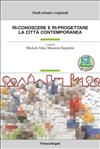
Il volume tenta di individuare nuovi percorsi di ricerca in grado di contribuire alla genesi di un nuovo modello di sviluppo e alla ri-configurazione dei problemi interpretativi e di progetto con cui dovranno misurarsi le città e i territori destinati a ospitare questo differente paradigma insediativo.
cod. 1740.130

Questo fascicolo dei Quaderni di Economia del Lavoro raccoglie alcuni contributi relativi a esperienze maturate nell’ambito di vari gruppi di ricerca afferenti alla sfera del Management della CSR (Corporate Social Responsibility), analizzando in particolare l’impatto che l’adozione di pratiche di CSR può avere sulla dimensione organizzativa e strategica delle imprese.
cod. 1280.96






Wind energy has grown significantly in the recent years worldwide, as an option in achieving sustainability in the energy sector. In Italy the wind capacity installed has boomed as well, in terms of capacity installed and government incentives given to the sector, achieving the record value od 5,797 MW installed in 2010, positioning itself 6th below countries as China, US, Germany, Spain and India. As a new developing sector, the present paper aims to investigate which are the features of the new emerging industry and which factors are affecting its competitiveness. Moreover, some findings have been used to identify and discuss which are the main weakness and strengths, threats and opportunities of the sector. In order to have an integrated picture of the industry competitiveness, they have been used those categories belonging to the theoretical framework of Porter’s Diamond Model, namely (1) Factor Conditions, (2) Demand Conditions, and (3) Firm’s Strategy, Structure and Rivalry, (4) Related and Support Industry, (5) Government and (6) Chance. The model has been adjusted taking into account some critics and improvements of the original Porter model. Each category has been analysed in details; data that comes from archival documents were reviewed carefully in order to select the more authoritative sources. A crucial part of the study concerns the analysis of technology capability and the firm’s strategy and rivalry and the support industry; arguments have been deepen by using a survey that has involved companies operating along the wind supply chain in Italy. The survey offered the opportunity to have a "firm’s perspective", concerning the perceptions of competitiveness opportunities and barriers by business executives who are dealing with local and global business situations. Moreover a final discussion of the main findings of the competitiveness analysis have been translated in terms of a SWOT analysis, that has the advantage of being easily readable by the industry itself and by decision makers. The main result of the study is that the growth in wind capacity installed in Italy has led to the development a new industry composed of multinational subsidiaries and local companies, operating in different areas of the supply chain has developed. The sector has been characterised by high dynamism and by increasing competitiveness, along the all supply chain that has promoted the development of new companies and new business that have had positive return on income and jobs. Positive advanced factor conditions, like physical resources, the high level of renewable energy demand due to the high fossil fuel dependance of Italy, government policies supporting the domestic market have positively influenced competitiveness of the industry. The main weakness of the industry is that it has still a marginal role in technology production, and R&D activities, which are commonly carried out abroad. However the learning process that has been created has been a stimulus for new turbine and component R&D activities. Therefore, actors and decision makers could attempt to further strengthen positive factors and overcome the negative ones in order to increase competitiveness of the national wind industry.



Geothermal resources in Italy and world-wide: scientific debate and market evolution - This paper describes the state of the art in development and utilization of geothermal resources in Italy and Tuscany. Departing from the geological peculiarities of this region, which have contributed to Italy’s leading role in technological innovation since the beginning of geothermoelectric power generation (GPG), recent evidences from the market and scientific community are here analyzed in order to answer the question whether the economic downturn will put geothermal energy on the back burner, or if it will function as a catalyst for change. The first section explores the role of geothermal energy within the renewable energy mix. After an introduction on the strengths and weaknesses of the Italian energy system, the evolution of the matches between different types of geothermal resources (high, medium and low enthalpies) and technologies is analyzed from an economic, technical and environmental point of view. Here, the evolution of the regulatory framework emerges as one of the main driving forces behind incremental innovation and the spreading of technologies. The move towards sustainability seems to stimulate the market in spite of the barriers to entry linked to capital intensiveness and the risks related to geothermal investments. Beside the growth of relationships between industrial actors, public administration and scientific community, the analysis identifies the downscale of plants, the integration with other "renewables" and the industrial integration as the main next challenges in the field of geothermal competitiveness. To this end, the implementation of such new tools for territorial management as the ones based on LCA (Life Cycle Assessment) and SMCE (Social Multi Criteria Evaluation) is expected to stimulate further improvements and innovations. The second section analyzes the present regulatory framework at the communitarian, national and local level and the allocation of economical resources to research and development in particular in relation to the distribution and characteristics of the geothermal resources. The specialization of Italy in GPG appears not to be adequately represented within European programmes and the Tuscany region is still considered not a leading market by the investors in geothermal heat pumps and geothermal district heating. Both according to the communitarian prescriptions and the requests from local actors, a few scenarios for the development of guidelines, certification schemes and regulations are here described. These elements are consistent with the purpose of sustainability and competitiveness of local economic activities. On the basis of these evidences, the third section describes the perspectives of development of medium and low enthalpy utilizations in Italy. According to the present financial incentives schemes and the predicted modifications in relevant regulations (i.e. city plans, building regulations, etc.), a booming growth of installations is expected. This geothermal "green new deal" is pulled by the increasing number of life-long learning programmes for professionals (i.e. geologists) and, even more, is expected to be pulled by the implementation of risk management tools and certification schemes. As result, the analysis sets a roadmap for addressing the needs of geothermal actors and removing the barriers to successful investing in this local and renewable energy resource. When we return to the initial question, it seems to be the moment for changing attitude towards energy production and to win back competitiveness and sustainability in the geothermal market.
Key words: Geothermal energy, renewable energy sources, energy policy, sustainable development, know how, industrial systems, certifications schemes, risk management.
JEL classifications: O13, Q42.
Parole chiave: Geotermia, fonti energetiche rinnovabili, politiche energetiche, sviluppo sostenibile, competenze, sistemi industriali, schemi di certificazione, gestione del rischio.
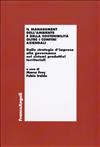
Dalle strategie d'impresa alla governance nei sistemi produttivi territoriali
Un approfondimento teorico ed empirico sul tema dell’approccio territoriale e “distrettuale” all’applicazione del Regolamento Comunitario EMAS (Environmental Management and Audit Scheme). Il tema lega strumenti innovativi di policy nel campo della sostenibilità, coniugando la dimensione internazionale delle politiche di sostenibilità con quella locale, in una logica di reciproca interazione finalizzata al miglioramento dell’efficacia delle politiche.
cod. 380.365

Partendo dalla ricognizione delle dinamiche che hanno interessato la trasformazione dello spazio alpino negli ultimi tre decenni, il testo propone un ragionamento sulle politiche per lo sviluppo della montagna, spesso prigioniero di una logica di pura conservazione delle strutture sociali, economiche e territoriali esistenti.
cod. 365.650

cod. 365.496
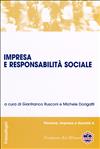
cod. 1135.6